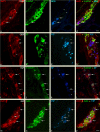Neurochemical characterization of zinc transporter 3-like immunoreactive (ZnT3(+)) neurons in the intramural ganglia of the porcine duodenum
- PMID: 22791190
- PMCID: PMC3447136
- DOI: 10.1007/s12031-012-9855-9
Neurochemical characterization of zinc transporter 3-like immunoreactive (ZnT3(+)) neurons in the intramural ganglia of the porcine duodenum
Abstract
The SLC30 family of divalent cation transporters is thought to be involved in the transport of zinc in a variety of cellular pathways. Zinc transporter 3 (ZnT3) is involved in the transport of zinc into synaptic vesicles or intracellular organelles. As the presence of ZnT3 immunoreactive neurons has recently been reported in both the central and peripheral nervous systems of the rat, the present study was aimed at disclosing the presence of a zinc-enriched neuron enteric population in the porcine duodenum to establish a preliminary insight into their neurochemical coding. Double- and triple-immunofluorescence labeling of the porcine duodenum for ZnT3 with the pan-neuronal marker (PGP 9.5), substance P, somatostatin, vasoactive intestinal peptide (VIP), nitric oxide synthase (NOS), leu-enkephalin, vesicular acetylcholine transporter (VAChT), neuropeptide Y, galanin (GAL), and calcitonin gene-related peptide were performed. Immunohistochemistry revealed that approximately 35, 43, and 48 % of all PGP9.5-postive neurons in the myenteric (MP), outer submucous (OSP), and inner submucous (ISP) plexuses, respectively, of the porcine duodenum were simultaneously ZnT3(+). In the present study, ZnT3(+) neurons coexpressed a broad spectrum of active substances, but co-localization patterns unique to the plexus were studied. In the ISP, all ZnT3(+) neurons were VAChT positive, and the largest populations among these cells formed ZnT3(+)/VAChT(+)/GAL(+) and ZnT3(+)/VAChT(+)/VIP(+) cells. In the OSP and MP, the numbers of ZnT3(+)/VAChT(+) neurons were two times smaller, and substantial subpopulations of ZnT3(+) neurons in both these plexuses formed ZnT3(+)/NOS(+) cells. The large population of ZnT3(+) neurons in the porcine duodenum and a broad spectrum of active substances which co-localize with this peptide suggest that ZnT3 takes part in the regulation of various processes in the gut both in normal physiology and during pathological processes.
Figures



Similar articles
-
Zinc Transporter 3 (Znt3) as an Active Substance in the Enteric Nervous System of the Porcine Esophagus.J Mol Neurosci. 2017 Mar;61(3):315-324. doi: 10.1007/s12031-016-0854-0. Epub 2016 Oct 30. J Mol Neurosci. 2017. PMID: 27796869 Free PMC article.
-
Chemical coding of zinc-enriched neurons in the intramural ganglia of the porcine jejunum.Cell Tissue Res. 2012 Nov;350(2):215-23. doi: 10.1007/s00441-012-1486-5. Epub 2012 Aug 24. Cell Tissue Res. 2012. PMID: 22918698 Free PMC article.
-
Architecture and Chemical Coding of the Inner and Outer Submucous Plexus in the Colon of Piglets.PLoS One. 2015 Jul 31;10(7):e0133350. doi: 10.1371/journal.pone.0133350. eCollection 2015. PLoS One. 2015. PMID: 26230272 Free PMC article.
-
Zinc transporter 3 (ZnT3) and vesicular zinc in central nervous system function.Neurosci Biobehav Rev. 2017 Sep;80:329-350. doi: 10.1016/j.neubiorev.2017.06.006. Epub 2017 Jun 15. Neurosci Biobehav Rev. 2017. PMID: 28624432 Review.
-
Correlated electrophysiological and histochemical studies of submucous neurons and their contribution to understanding enteric neural circuits.J Auton Nerv Syst. 1988 Nov;25(1):1-13. doi: 10.1016/0165-1838(88)90002-1. J Auton Nerv Syst. 1988. PMID: 3066810 Review.
Cited by
-
Physiological Concentrations of Zinc Have Dual Effects on P2X Myenteric Receptors of Guinea Pig.Cell Mol Neurobiol. 2018 Oct;38(7):1439-1449. doi: 10.1007/s10571-018-0612-7. Epub 2018 Aug 14. Cell Mol Neurobiol. 2018. PMID: 30109516 Free PMC article.
-
Zinc Transporter 3 (ZnT3) in the Enteric Nervous System of the Porcine Ileum in Physiological Conditions and during Experimental Inflammation.Int J Mol Sci. 2017 Feb 7;18(2):338. doi: 10.3390/ijms18020338. Int J Mol Sci. 2017. PMID: 28178198 Free PMC article.
-
Zinc Transporter 3 (Znt3) as an Active Substance in the Enteric Nervous System of the Porcine Esophagus.J Mol Neurosci. 2017 Mar;61(3):315-324. doi: 10.1007/s12031-016-0854-0. Epub 2016 Oct 30. J Mol Neurosci. 2017. PMID: 27796869 Free PMC article.
-
Somatostatin as an Active Substance in the Mammalian Enteric Nervous System.Int J Mol Sci. 2019 Sep 10;20(18):4461. doi: 10.3390/ijms20184461. Int J Mol Sci. 2019. PMID: 31510021 Free PMC article. Review.
-
Co-localization of zinc transporter 3 (ZnT3) with sensory neuromediators and/or neuromodulators in the enteric nervous system of the porcine esophagus.Biometals. 2017 Jun;30(3):393-403. doi: 10.1007/s10534-017-0014-1. Epub 2017 Apr 17. Biometals. 2017. PMID: 28417221 Free PMC article.
References
-
- Boeckxstaens GE, Pelckmans PA, Herman AG, Van Maercke YM. Involvement of nitric oxide in the inhibitory innervation of the human isolated colon. Gastroenterology. 1993;104:690–697. - PubMed
Publication types
MeSH terms
Substances
LinkOut - more resources
Full Text Sources
Research Materials
Miscellaneous

